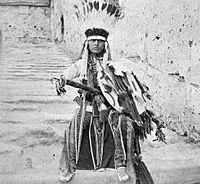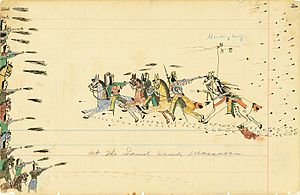Howling Wolf (Cheyenne) facts for kids
Quick facts for kids
Howling Wolf
|
|
|---|---|

Howling Wolf while imprisoned at Fort Marion
|
|
| Born |
Ho-na-nist-to
1849 |
| Died | July 5, 1927 (aged 77–78) |
| Education | Self-taught |
| Known for | Painter |
| Movement | Ledger art |
Howling Wolf (in Cheyenne: Ho-na-nist-to) was a brave Southern Cheyenne warrior. He was born in 1849 and passed away on July 5, 1927. Howling Wolf was part of Black Kettle's group and was present at the Sand Creek Massacre in Colorado. After being held captive at Fort Marion in Saint Augustine, Florida starting in 1875, Howling Wolf became a very skilled artist. His unique art style is known as Ledger art, named after the old accounting books he used for his drawings.
Contents
The Sand Creek Attack
Howling Wolf, who was only 15 years old, was with his father, Eagle Head, at their Southern Cheyenne camp. This camp was located on Sand Creek in Colorado Territory. On the morning of November 29, 1864, their camp was suddenly attacked. Colonel John Chivington and his soldiers, the First Regiment of Colorado Volunteers, launched the surprise attack.
The Cheyenne camp was not ready for a fight. The U.S. Army had told Black Kettle to set up camp there, and most of the warriors were away hunting. Howling Wolf and his father were among the few warriors who tried to defend their people. About 137 Cheyenne and Arapaho people died in this attack. Most of those who died were women and children. This sad event is now known as the Sand Creek Massacre.
Becoming a Prisoner of War
In 1875, Howling Wolf and Eagle Head were taken prisoner. They were part of a group of Native Americans from different tribes. This group included 33 Southern Cheyenne, 11 Comanche, 27 Kiowa, and one Caddo person. They were first held at Fort Sill, Oklahoma.
From Fort Sill, they traveled by wagon to Fort Leavenworth, Kansas. Then, they boarded a special train that took them east. Their final destination was an old Spanish fort in St. Augustine, Florida. The U.S. Army had renamed this fort Fort Marion.
Amazing Artwork: Ledger Art
While he was a prisoner at Fort Marion, Howling Wolf became a very talented artist. His art style is called Ledger Art. It got this name because he drew on paper from old accounting ledger books. This type of paper was the easiest to find at the time.
His drawings were similar to the traditional Plains hide painting done by his people. Howling Wolf's artwork, along with drawings by other ledger artists, was sold to tourists visiting the fort in St. Augustine. Today, these artworks are very valuable. They are important because they show us what life was like for these artists and their tribes, seen through their own eyes.
Life After Prison
Besides becoming an artist, Howling Wolf was made a sergeant. He was in charge of the "Indian guard" at the fort, which was a group of Native American prisoners. While at Fort Marion, he and other captives learned many things. They were taught by Captain Richard Henry Pratt and learned to read and write English.
Howling Wolf spent three years as a prisoner. He was finally released in 1878. After his release, he returned to Oklahoma to live on the Cheyenne reservation. He had thought about staying in the East to continue his education. However, his eyesight started to get worse. He even sailed to Boston for an eye operation. Because of his vision problems, he decided to go back to the reservation.
In 1881, Howling Wolf felt that the ways of the white European Americans did not suit him anymore. He decided to go back to wearing traditional Cheyenne clothing. He also became involved with the Native American Church, along with other Cheyenne people like Roman Nose.
His Final Years
Howling Wolf passed away in 1927. He was in a car accident while on his way home to Oklahoma. He had been performing in a Wild West show in Houston, Texas.
See also


